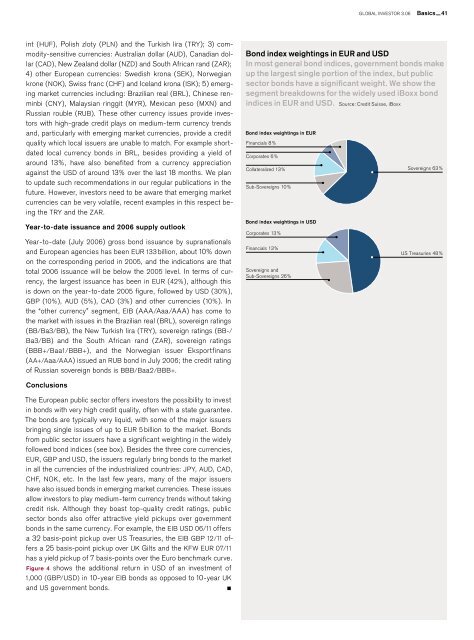Banking for 7 billion and 7 million
New challenges and opportunities of globalization Global Investor, 03/2006 Credit Suisse
New challenges and opportunities of globalization
Global Investor, 03/2006
Credit Suisse
Create successful ePaper yourself
Turn your PDF publications into a flip-book with our unique Google optimized e-Paper software.
GLOBAL INVESTOR 3.06 Basics — 41<br />
int (HUF), Polish zloty (PLN) <strong>and</strong> the Turkish lira (TRY); 3) commodity-sensitive<br />
currencies: Australian dollar (AUD), Canadian dollar<br />
(CAD), New Zeal<strong>and</strong> dollar (NZD) <strong>and</strong> South African r<strong>and</strong> (ZAR);<br />
4) other European currencies: Swedish krona (SEK), Norwegian<br />
krone (NOK), Swiss franc (CHF) <strong>and</strong> Icel<strong>and</strong> krona (ISK); 5) emerging<br />
market currencies including: Brazilian real (BRL), Chinese renminbi<br />
(CNY), Malaysian ringgit (MYR), Mexican peso (MXN) <strong>and</strong><br />
Russian rouble (RUB). These other currency issues provide investors<br />
with high-grade credit plays on medium-term currency trends<br />
<strong>and</strong>, particularly with emerging market currencies, provide a credit<br />
quality which local issuers are unable to match. For example shortdated<br />
local currency bonds in BRL, besides providing a yield of<br />
around 13%, have also benefited from a currency appreciation<br />
against the USD of around 13% over the last 18 months. We plan<br />
to update such recommendations in our regular publications in the<br />
future. However, investors need to be aware that emerging market<br />
currencies can be very volatile, recent examples in this respect being<br />
the TRY <strong>and</strong> the ZAR.<br />
Bond index weightings in EUR <strong>and</strong> USD<br />
In most general bond indices, government bonds make<br />
up the largest single portion of the index, but public<br />
sector bonds have a significant weight. We show the<br />
segment breakdowns <strong>for</strong> the widely used iBoxx bond<br />
indices in EUR <strong>and</strong> USD. Source: Credit Suisse, iBoxx<br />
Bond index weightings in EUR<br />
Financials 8%<br />
Corporates 6%<br />
Collateralized 13%<br />
Sub-Sovereigns 10%<br />
Sovereigns 63%<br />
Year-to-date issuance <strong>and</strong> 2006 supply outlook<br />
Year-to-date (July 2006) gross bond issuance by supranationals<br />
<strong>and</strong> European agencies has been EUR 133 <strong>billion</strong>, about 10% down<br />
on the corresponding period in 2005, <strong>and</strong> the indications are that<br />
total 2006 issuance will be below the 2005 level. In terms of currency,<br />
the largest issuance has been in EUR (42%), although this<br />
is down on the year-to-date 2005 figure, followed by USD (30%),<br />
GBP (10%), AUD (5%), CAD (3%) <strong>and</strong> other currencies (10%). In<br />
the “other currency” segment, EIB (AAA/Aaa/AAA) has come to<br />
the market with issues in the Brazilian real (BRL), sovereign ratings<br />
(BB/Ba3/BB), the New Turkish lira (TRY), sovereign ratings (BB-/<br />
Ba3/BB) <strong>and</strong> the South African r<strong>and</strong> (ZAR), sovereign ratings<br />
(BBB+/Baa1/BBB+), <strong>and</strong> the Norwegian issuer Eksportfinans<br />
(AA+/Aaa/AAA) issued an RUB bond in July 2006; the credit rating<br />
of Russian sovereign bonds is BBB/Baa2/BBB+.<br />
Conclusions<br />
The European public sector offers investors the possibility to invest<br />
in bonds with very high credit quality, often with a state guarantee.<br />
The bonds are typically very liquid, with some of the major issuers<br />
bringing single issues of up to EUR 5 <strong>billion</strong> to the market. Bonds<br />
from public sector issuers have a significant weighting in the widely<br />
followed bond indices (see box). Besides the three core currencies,<br />
EUR, GBP <strong>and</strong> USD, the issuers regularly bring bonds to the market<br />
in all the currencies of the industrialized countries: JPY, AUD, CAD,<br />
CHF, NOK, etc. In the last few years, many of the major issuers<br />
have also issued bonds in emerging market currencies. These issues<br />
allow investors to play medium-term currency trends without taking<br />
credit risk. Although they boast top-quality credit ratings, public<br />
sector bonds also offer attractive yield pickups over government<br />
bonds in the same currency. For example, the EIB USD 06/11 offers<br />
a 32 basis-point pickup over US Treasuries, the EIB GBP 12/11 offers<br />
a 25 basis-point pickup over UK Gilts <strong>and</strong> the KFW EUR 07/11<br />
has a yield pickup of 7 basis-points over the Euro benchmark curve.<br />
Figure 4 shows the additional return in USD of an investment of<br />
1,000 (GBP/USD) in 10-year EIB bonds as opposed to 10-year UK<br />
<strong>and</strong> US government bonds. <br />
<br />
Bond index weightings in USD<br />
Corporates 13%<br />
Financials 13%<br />
Sovereigns <strong>and</strong><br />
Sub-Sovereigns 26%<br />
US Treasuries 48%

















